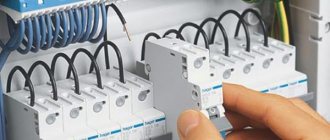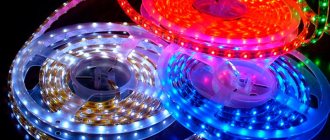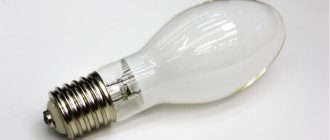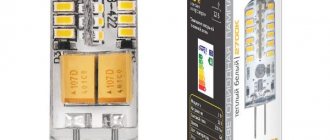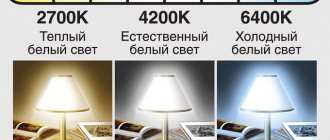Halogen lamp protection block Granite
Halogen lamps have an unpleasant feature - they burn out when turned on. Conventional lamps, of course, also have this disadvantage, but not to such an extent.
Halogen and incandescent lamps, as a rule, burn out when turned on, when the filament is still relatively cold and its resistance is low. In this case, a large current jump occurs, and a short-term high power is released on the spiral. This effect is described in detail on SamElectric in the article Resistance of an Incandescent Lamp Filament.
To extend the life of halogen lamps, such a device was invented - a halogen lamp protection unit . The principle of operation of the protection unit is extremely simple - since the lamp burns out at the moment of a sharp jump in current through it, this device is connected in series with the lamp and limits the current at the initial moment.
The current, and therefore the brightness, gradually increases over 1 - 2 seconds. Connecting the protection unit is not difficult. It has two terminals, polarity, input-output and phase-ground do not matter. It is better to connect it in series with the switch in a phase break.
Such a unit is sometimes called a soft starter, a protection device, or a protection device. The device is used not only for halogen, but also for conventional incandescent lamps.
Selecting a protective block
When selecting a suitable soft starter, it is recommended to take into account two factors - power and manufacturer. The power of the block is discussed above. As for brands, the most famous companies are:
- "Feron" (PRC);
- "Camelion" (PRC);
- "Shepro" (Russia);
- “Granit 1000”, “Granit 500” (Belarus);
- "Composite" (Russia);
- “Zipper” (co-production between Russia and China).
The most popular models are also produced by “Granite”. The products of the Chinese manufacturer have low prices. Like most products from China, blocks from China are considered not of very high quality. They are characterized by the following disadvantages:
- voltage drops, which disrupts the operation of the lamp;
- flashing of the lamp when connected and during operation;
- regular interference;
- average soldering quality;
- savings on the materials from which the block is made.
The products of the Belarusian company are considered to be of significantly higher quality. However, “Granite” is not compact, which in some cases is a critical drawback (for example, when placing a switch in a socket box). It should also be noted that the cost of “Granite” is higher than that of Chinese manufacturers.
Lamp protection block granite bz 500 in Tver
An “Online Consultant” is available on the seller’s website. To go to the site, click “Go to store”
A toll-free number 8-800 is available on the seller's website. To go to the site, click “Go to store”
An “Online Consultant” is available on the seller’s website. To go to the site, click “Go to store”
An “Online Consultant” is available on the seller’s website. To go to the site, click “Go to store”
An “Online Consultant” is available on the seller’s website. To go to the site, click “Go to store”
A toll-free number 8-800 is available on the seller's website. To go to the site, click “Go to store”
“One-click ordering” is available on the seller’s website. To go to the site, click “Go to store”
An “Online Consultant” is available on the seller’s website. To go to the site, click “Go to store”
A toll-free number 8-800 is available on the seller's website. To go to the site, click “Go to store”
“One-click ordering” is available on the seller’s website. To go to the site, click “Go to store”
An “Online Consultant” is available on the seller’s website. To go to the site, click “Go to store”
A toll-free number 8-800 is available on the seller's website. To go to the site, click “Go to store”
“One-click ordering” is available on the seller’s website. To go to the site, click “Go to store”
An “Online Consultant” is available on the seller’s website. To go to the site, click “Go to store”
A toll-free number 8-800 is available on the seller's website. To go to the site, click “Go to store”
“One-click ordering” is available on the seller’s website. To go to the site, click “Go to store”
A toll-free number 8-800 is available on the seller's website. To go to the site, click “Go to store”
“One-click ordering” is available on the seller’s website. To go to the site, click “Go to store”
A toll-free number 8-800 is available on the seller's website. To go to the site, click “Go to store”
“One-click ordering” is available on the seller’s website. To go to the site, click “Go to store”
An “Online Consultant” is available on the seller’s website. To go to the site, click “Go to store”
A toll-free number 8-800 is available on the seller's website. To go to the site, click “Go to store”
An “Online Consultant” is available on the seller’s website. To go to the site, click “Go to store”
“One-click ordering” is available on the seller’s website. To go to the site, click “Go to store”
An “Online Consultant” is available on the seller’s website. To go to the site, click “Go to store”
A toll-free number 8-800 is available on the seller's website. To go to the site, click “Go to store”
A toll-free number 8-800 is available on the seller's website. To go to the site, click “Go to store”
An “Online Consultant” is available on the seller’s website. To go to the site, click “Go to store”
A toll-free number 8-800 is available on the seller's website. To go to the site, click “Go to store”
An “Online Consultant” is available on the seller’s website. To go to the site, click “Go to store”
An “Online Consultant” is available on the seller’s website. To go to the site, click “Go to store”
A toll-free number 8-800 is available on the seller's website. To go to the site, click “Go to store”
An “Online Consultant” is available on the seller’s website. To go to the site, click “Go to store”
An “Online Consultant” is available on the seller’s website. To go to the site, click “Go to store”
A toll-free number 8-800 is available on the seller's website. To go to the site, click “Go to store”
“One-click ordering” is available on the seller’s website. To go to the site, click “Go to store”
An “Online Consultant” is available on the seller’s website. To go to the site, click “Go to store”
A toll-free number 8-800 is available on the seller's website. To go to the site, click “Go to store”
“One-click ordering” is available on the seller’s website. To go to the site, click “Go to store”
A toll-free number 8-800 is available on the seller's website. To go to the site, click “Go to store”
An “Online Consultant” is available on the seller’s website. To go to the site, click “Go to store”
A toll-free number 8-800 is available on the seller's website. To go to the site, click “Go to store”
“One-click ordering” is available on the seller’s website. To go to the site, click “Go to store”
A toll-free number 8-800 is available on the seller's website. To go to the site, click “Go to store”
“One-click ordering” is available on the seller’s website. To go to the site, click “Go to store”
How to connect 12-volt halogen lamps?
A halogen lamp is almost similar in design to an incandescent lamp, which means that the power source is not particularly important for it. They can be connected to network transformers, but more often so-called electronic transformers are used.
An electronic transformer (ET) is a pulsed power supply, which is usually based on a self-oscillator circuit. Its main feature is that the output is an alternating high-frequency pulsating voltage, the approximate shape of which you can see in the following oscillogram.
Widespread use is due to a number of advantages over network 50 Hz transformers, such as:
— with the same power, the dimensions of the electric vehicle are several times smaller and lighter;
— there is no low-frequency hum, like its 50 Hz counterparts;
- low cost.
You can see a typical electronic transformer below. The inscription INPUT is highlighted in red and the arrow shows the black wires that come out of the case opposite it - they are connected to a 220V network, and the green OUTPUT and two white wires are the low voltage output, 12V light bulbs or lamps are connected to these wires
Pay attention to the words “AC OUTPUT 12V 60W MAX” - this means that the output is alternating current
When connecting halogen lamps, we see that they operate normally.
If you simply replace them with LED bulbs, they will also seem to glow, but it’s not that simple.
You can observe a barely noticeable flicker; on some light bulbs it is more pronounced, and on others it is weaker, which is primarily due to the pulsating output voltage and the circuit design of the lamp itself. The camera does not transmit these flickers, and there was no heart rate monitor at hand, but there is an easy way to roughly evaluate the pulsations of the light flux - a mobile phone camera. If there are pronounced horizontal stripes in the frame, then there is something wrong with the lighting, and the closer you bring the camera, the more noticeable these stripes are.
You may have noticed that different light bulbs were used, this is not just the case. Let's figure out how they work
Conventionally, 12V LED lamps can be divided into 2 groups:
- “cheap and simple”, in which a diode bridge, resistors and LEDs are installed. The diode bridge allows operation from alternating voltage, and when connected to a direct voltage source, the polarity does not matter. Resistors are needed to limit the current. You see such a lamp in the picture on the right. In the close-up, two resistors and a diode bridge are visible through the silicone shell; they are located on both sides of the printed circuit board. The shell is elastic, but quite hard, vaguely reminiscent of bouncing balls.
- “expensive and complex”, in which the current is not limited by resistors, but is stabilized using a pulse converter. This particular instance does not use a set of discrete SMD LEDs, but a separate crystal filled with a yellow phosphor.
Power surges
Power surges are a fairly common occurrence in our country. Oddly enough, LED lamps treat voltage increases above the rated value quite calmly. Power drivers can handle them easily.
More dangerous for LEDs are voltage drops when, in a fraction of a second, the current passing through the semiconductor layer drops and then returns to its original values. Then a point breakdown can occur in the space of the pn junction. The power driver is able to cut off excess current, but is not able to compensate for its pronounced drop.
The protection of LED lamps is partially solved by a high-voltage capacitor of medium capacity installed in front of the driver, which plays the role of an anti-aliasing filter.
Fatal power surges
The situation that I want to touch upon is rather an exception to the rule, however, such cases occur with enviable regularity. We are talking about lightning strikes. But not into a power line - such situations are exactly safe, since due to the instantaneous melting of the wires, the charge most likely will not reach the end consumer of electricity. Lightning strikes in the immediate vicinity of a power line are dangerous.
The corona discharge voltage reaches millions of volts and a powerful electromagnetic field is formed around the lightning channel. If a transmission line is in its area of action, there will be an instant surge in current and voltage.
The front of the voltage amplitude rise is so fast that the protective cascades of the electronics do not have time to cope and entire boards burn out. There will be numerous crystal breakdowns in an LED light bulb. We classified such power surges as fatal, since there is no adequate protection against such force majeure.
During normal operation, a phenomenon such as flickering of lamps when switched off occurs.
We have already discussed the blinking of switched-on lamps in detail in this article.
Installation and connection
The installation of the protective block is usually carried out on the ceiling, that is, where the lighting devices are fixed. If the light bulb is not the only one, the soft starter is installed before the first light source.
The blocks are also placed in mounting boxes under the light switch. However, it should be borne in mind that there is a limitation for placing the unit in a mounting box: the maximum power of the device should not exceed 300 W.
Note! Whatever location is chosen for installing the unit, the device must be provided with unobstructed access for repair work. A typical block connection diagram is shown in the figure below
A typical block connection diagram is shown in the figure below.
In the case of an illuminated switch, a resistor is connected in parallel to the block. The resistance level for the resistor should be in the range of 33–100 kOhm, and the power should not exceed 2 W.
For 12 volt lamps a protection unit is also required. When using an electromagnetic transformer, the unit is placed in the gap of the primary winding. For an electronic transformer you will need a special block with four inputs.
The power level of the unit is selected based on the total power of all consumers. In this case, a certain power reserve is required, usually within 50% of the nominal value of all lighting devices.
For normal operation of the protective unit, it must be cooled. To allow air to enter, special holes are created in the housing.
Precautionary measures
When a light bulb burns out, the filament opens, which leads to a short circuit. As a result, there is a risk of failure of the protective unit. To prevent this, do the following:
The protective device is installed in the most accessible area (socket box or panel). Getting to the ceiling block will be much more difficult. Install a dedicated circuit breaker on each line
The nominal value of the switch is selected with a small margin, since current drops are not taken into account with this connection option. Installation of the protective unit in rooms with high humidity levels is not allowed.
Electrical company
- Warehouse goods
- Sale
- Full catalog
There are no products in the selected category. Return to the beginning of the directory.
Protection blocks "Granite"
Granite lamp protection units prevent frequent burnout of your halogen and incandescent lamps and ensure their long-term operation. The unique soft start system of the Granit blocks protects the light bulbs from destructive current surges when turned on. And during operation of the Granite lamps, they stabilize the voltage on them, regardless of voltage drops in the network.
Personal production of UPVL
Devices with which you can start a smooth start can be made independently. For a thyristor circuit, a lamp is included in the rectifier bridge circuit. It acts as a limiter. The rectifier arms contain a shifting chain and the thyristor itself. Installation of a diode bridge is required.
After voltage has been applied to the circuit, the current, passing through the tungsten helix and the rectifier bridge, enters the resistor. The electrolyte container begins to heat up. The thyristor opens and passes current through itself. The tungsten filament heats up smoothly, the heating time depends on the resistor and capacitor.
Triac-based circuit
In the circuit for smooth switching on of lighting devices, the triac acts as a power switch. The choke, as the main part, is a coil of copper wires, on the core of which a magnetic circuit is wound. The current strength in the windings increases gradually; the magnetic field is not able to quickly change direction. A triac (symmetrical thyristor) combines 2 stabilizers under the housing.
A resistor that transmits voltage to the electrical electrode acts as a current limiter. The circuit that sets the time is connected to a resistor and an electrolyte capacitance. Compared to a thyristor device, a triac has several disadvantages: when working with an inductive load, voltage surges are critical.
Devices can switch quickly. The reliability of the devices is ensured by the absence of mechanical parts and contacts. To increase the dimensions, the triac must be connected to a radiator to minimize the degree of heating of the electronic keys. Fans can be equipped additionally; they help to quickly cool electronic parts.
IC based
Microcircuits that allow smooth start-up were specially designed for faster construction of phase regulators. The small design is capable of controlling the voltage supplied to the lamp (up to 150 V). To increase the current when there are several lighting fixtures in the same room, a triac is connected to the microcircuit.
The devices can be used for soft starting of not only incandescent lamps, but also halogen lamps. To extend the life of an electrical appliance, you can install parts that have a similar mechanism of action.
Inside most microcircuits there are parts responsible for signal amplification. The load is completely switched off at zero. The control circuit is closed under the influence of a capacitor, which charges quite quickly. This allows for smooth acceleration. To be able to quickly turn off the power supply, it is advisable to install an emergency switch.
Induced pulsation
The current required to operate LEDs is very small - microamps. If two lines of indoor wiring are in close proximity, and a powerful load is switched on in one of the lines, electromagnetic waves can excite a current in the conductor sufficient for the LED to glow.
Perpetual LEDs are the same myth as perpetual motion machines. Each episode of switching on/off reduces its lifespan a little. No one has measured this parameter for LEDs, but with an event frequency of fifty times per second (the network ripple frequency is 50 Hz), even very large numbers are a relative concept.
A simple diagram for DIY assembly
The circuit below is easy to assemble, reliable and notable in that it is designed not only for smooth switching on of 220V incandescent lamps, but also for their smooth switching off. It is also worth noting that the flash and fadeout delays are set at the assembly stage at your own discretion.
Scheme
A schematic diagram of the smooth switching on of incandescent lamps is shown in the figure below. It is based on the KR1182PM1 (DIP8) microcircuit, inside of which there are two thyristors and two control systems for them. Capacitor C3 and resistor R2 set the duration of smooth on and off, respectively. Triac VS1 is necessary to separate the power and control parts, and resistor R1 sets the control electrode current. C1, C2 – external capacitors necessary to control the operation of thyristors inside KR1182PM1. Chain R4, C4 protects circuit elements from network interference.
Principle of operation
In the initial position, the contacts of switch SA1 must be closed. This nuance should be taken into account when connecting the board to the wall switch. At the moment the contacts SA1 open, capacitor C3 begins to gain capacity, thereby launching the thyristor control system into operation. At the output of the IC, through resistor R1, a gradual increase in current occurs, which controls the operation of the power switch. The result of the operation of the control system is a smooth start of the triac VS1 and the EL1 light bulb connected in series with it.
The rate of current rise at the control electrode depends on the value of capacitor C3. In order for the lamp to gradually light up within 3 seconds, capacitance C3 must be 100 μF. To increase the time to 10 seconds, you will have to set C3 to 470 uF. The soft shutdown duration is set by resistor R2. It is recommended to start selection with a nominal value of 2 kOhm.
Printed circuit board and assembly parts
- DA1 – KR1182PM1;
- C1, C2 – 1 µF-16V (polar);
- C3 – 470 uF-16V (polar);
- C4 – 0.1 uF-630V (non-polar);
- R1 – 470 Ohm-0.25 W±5%;
- R2 – 3 kOhm-0.25 W±5%;
- R4 – 51 Ohm-0.25 W±5%;
- VS1 – KU208G.
The use of devices that ensure smooth switching on of incandescent lamps has been benefiting people for several decades.
With the help of UPVL, the service life of incandescent light bulbs increases by at least 40%. As for the above scheme, its performance and reliability have been tested from our own experience. No tags for this post.
Smooth switching on of incandescent lamps will extend their service life. Scheme for smooth switching on of lamps.
The situation when an incandescent lamp fails and at the same time many dangerous fragments fly around the room is by no means new. Moreover, this can happen both with a long-running instance, and with one installed quite recently. They burn out the moment they are turned on, because for a very short period of time (literally tenths of a second) the amount of current that comes to the filament is significantly higher than its rated value, but this is enough for it to burn out.
The situation can be corrected by smoothly switching on incandescent lamps , the basis of which is a device - a protection unit, which allows for fairly slow (2-3 s) ignition of the tungsten filament. You can make it yourself or purchase it ready-made.
Features of choosing a protection unit
When choosing such a device, you should take into account the total load, which is easy to calculate, taking into account the number of incandescent lamps and their power. This value requires a power reserve; it is better if this value is approximately a quarter of the obtained value. This will extend the life of the device, ensuring smooth switching on of incandescent lamps. Overloading the unit is unacceptable, as this will lead to significant overheating of all elements, and it will quickly break.
One of the acceptable options is the Uniel Upb-200W-BL . You can connect fluorescent lamps with a total power of no more than 160W to it. Just keep in mind that the use of a protective block leads to a voltage drop, so the load is noticeably reduced and is only 171V.

